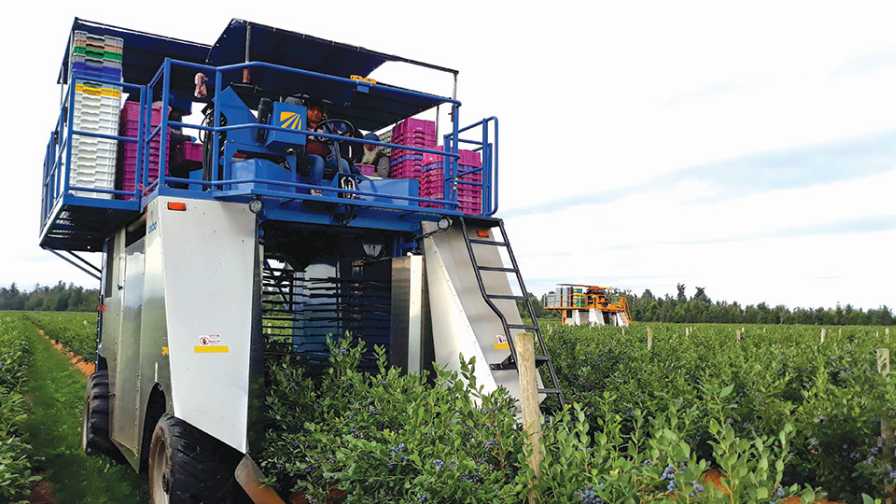Berry Experts Flesh Out Future of the Industry

Trends in berry crops? We’ll continue to see more mechanical blueberry harvesters in the coming years.
Photo by Lisa DeVetter
Recently, we asked our veteran berry columnist, John R. Clark, a distinguished Professor of horticulture at the University of Arkansas, as well as our newest berry columnist, Lisa DeVetter, an Assistant Professor of horticulture at Washington State University whose column will debut in American Fruit Grower magazine’s April issue, to provide some insights for 2020.
Here’s what they had to say.
John R. Clark
Berry crops continue to experience exciting times for consumers, growers, and marketers. For 2020, this reality should continue. Positive factors for 2020 include new variety introductions across all berry crops, continued grower innovations in management of the crops, and continued consumer interest in berries for health benefits.
Jim Hancock with Sam’s Club provides a berry category overview: “Overall berries are still a growth category for retail. At Sam’s Club we see berries as an opportunity to differentiate ourselves by partnering with growers focused on varieties with the best flavor. Blackberries and raspberries have experienced the largest growth in 2019 and we expect that to continue in 2020. New varieties with better flavor and availability are helping drive that trend.”

John R. Clark
Hancock continues: “In terms of challenges for the industry, weather continues to be the biggest unknown, creating temporary disruptions in both supply and quality. Labor shortages and rising costs are also impacting growers. For Sam’s Club, we are continuing what has been a long-term journey to develop relationships with berry suppliers that are staying in front of innovation and new varietal development.”
As for strawberry growers, local markets remain strong. Grower Jeff Crotts, Lincolnton, NC, comments that the first berries of the season are always popular, and local sales continue to grow in his area. California production and profitability continues with challenges, but production remains strong with high-yielding varieties. Dr. Vance Whitaker at the University of Florida shares that “one of the main questions for growers is how the rapidly changing variety landscape will affect the supply and thus the market.”
Finally, blueberries continue to be tremendously popular in the U.S. with more berries on the market each year. Rod Cook with Agview Consulting indicates that “challenges in the domestic industry include pressures from imports from Mexico and Peru for the shoulder seasons for very early and late berries.”
Lisa DeVetter
The drive to machine-harvest blueberries for fresh market will continue to increase as sourcing affordable labor becomes more challenging. Improved machine harvesting and sorting technologies will support this transition to machine-harvesting fresh market blueberries with good quality.
Use of polyethylene mulches for establishing tissue culture red raspberries is expected to increase in floricane systems in the Northwest. These systems traditionally established plants without mulches, using herbicides and hand weeding to manage weeds.

Lisa DeVetter
Biodegradable plastic mulch alternatives are being explored as alternatives to polyethylene mulches in both strawberry and raspberry systems. Adoption is expected to be slow as industry learns about the compatibility of these materials in their systems and expectations for in-soil biodegradation.
Look forward to continued expansion of fresh market strawberry production for local markets in the Pacific Northwest. Research and breeding efforts are underway on how to support fresh market strawberry production using day-neutral/remontant cultivars.
Washington and Oregon will continue to lead in total highbush blueberry production in the U.S. British Columbia will also continue to be a significant international producer. Expect Washington to continue to lead in the organic fresh and processed sectors for organic highbush blueberry production, as more land has been planted with organic blueberry and some existing fields have still not reached full production potential.
Increasing market competition, low sales, and/or increasing production costs will continue to challenge small fruit producers in the U.S. Small fruit growers and crop advisors will need to focus on efficient production in order to stay profitable and many research aims are supporting this goal. Marketing aims will need to continue to promote sales of U.S.-grown berries to help growers stay profitable and relevant in the increasingly competitive global marketplace. Some industries will also continue to look overseas to build foreign markets.
Fungicide resistance will continue to be an important issue for growers to manage.
More insect pests have surfaced in the U.S., including spotted lanternfly (Lycorma delicatula) on the East Coast. Brown marmorated stink bug (Halyomorpha halys) really hasn’t manifested into a big issue for small fruit production in the Pacific Northwest and spotted wing drosophila (Drosophila suzukii; SWD) continues to be the major insect pest in these systems. Secondary pests, like mites, will emerge and become more problematic in systems that intensively manage SWD using certain chemistries. Look for new SWD products that use “softer” management approaches and stay tuned to efficacy reports (e.g., “gums”, “splats”, etc.).









